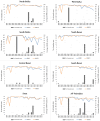Measles Epidemiology and Coverage of Immunization Against Measles in the Autonomous Province of Vojvodina, Serbia: Local Trends in a Regional Context
- PMID: 40733688
- PMCID: PMC12300201
- DOI: 10.3390/vaccines13070711
Measles Epidemiology and Coverage of Immunization Against Measles in the Autonomous Province of Vojvodina, Serbia: Local Trends in a Regional Context
Abstract
Background: Despite ongoing global elimination efforts, measles remains a persistent public health threat.
Methods: This retrospective observational study examines trends in crude measles incidence and vaccination coverage from 1948 to 2024 in the northern region of Serbia-Autonomous Province of Vojvodina (AP Vojvodina)-which accounts for 26.9% of the national population. This study further explores measles vaccination coverage across the province's seven districts, along with the number of reported measles cases, age distribution, and vaccination status of affected individuals from 2000 to 2024. Data were obtained from official annual immunization records maintained by public health institutions within the framework of Serbia's national mandatory immunization program.
Results: A notable resurgence of measles occurred in Serbia during 2017-2018, following a decline in vaccination coverage. In AP Vojvodina, outbreaks were recorded in 2007, 2014-2015, and 2017-2018, predominantly affecting unvaccinated children and adults aged 20-39 years. Since 2019, the measles incidence has significantly declined. During the 2018 outbreak, the highest incidence was observed among children aged 1-4 years (40.6 per 100,000), followed by infants under 1 year (17.3 per 100,000) and adults aged 20-39 years (12.5 per 100,000). An analysis of the data from 2000 to 2024 revealed substantial age- and dose-related differences in measles incidence, particularly among unvaccinated individuals, those who had received one or two doses of a measles-containing vaccine (MCV), and those with unknown vaccination status. During the 2017-2018 epidemic, unvaccinated children under 1 year and those aged 1-4 years were the most affected. A marked increase in cases among single-dose recipients was noted in 2018, especially in adults aged 20-39 years (9.5%) and those ≥40 years (13.5%). A considerable proportion of measles cases in these age groups had unknown vaccination status: 33.1% among individuals aged 20-39 years and 18.2% among those aged ≥ 40 years. Epidemiological investigation linked the 2007 and 2014-2015 outbreaks in AP Vojvodina to importations from Bosnia and Herzegovina. No specific source was identified for the 2017-2018 outbreak, suggesting possible endemic transmission.
Conclusions: These findings underscore the impact of fluctuating vaccination coverage on measles resurgence. Sustaining high two-dose MCV coverage, strengthening routine immunization programs, enhancing surveillance systems, and ensuring timely outbreak preparedness are critical measures for achieving effective measles control.
Keywords: AP Vojvodina; Serbia; epidemiology; herd immunity; immunization programs; measles; outbreaks; vaccination coverage.
Conflict of interest statement
The authors declare no conflicts of interest.
Figures





Similar articles
-
Herd Immunity to the Measles, Mumps and Rubella Viruses Among the Belgradian Population in May, 2024.Vaccines (Basel). 2025 Jun 18;13(6):652. doi: 10.3390/vaccines13060652. Vaccines (Basel). 2025. PMID: 40573983 Free PMC article.
-
Immunogenicity and safety of a measles and rubella-containing vaccine at age 6 and 9 months in Bangladesh: an open-label, randomised trial.Lancet Child Adolesc Health. 2025 May;9(5):306-314. doi: 10.1016/S2352-4642(25)00090-2. Epub 2025 Mar 31. Lancet Child Adolesc Health. 2025. PMID: 40179934 Free PMC article. Clinical Trial.
-
Estimating the health effects of COVID-19-related immunisation disruptions in 112 countries during 2020-30: a modelling study.Lancet Glob Health. 2024 Apr;12(4):e563-e571. doi: 10.1016/S2214-109X(23)00603-4. Lancet Glob Health. 2024. PMID: 38485425 Free PMC article.
-
Vaccine preventable diseases and vaccination coverage in Australia, 1993-1998.Commun Dis Intell. 2000 Jun;Suppl:v-83. doi: 10.33321/cdi.2000.24.21. Commun Dis Intell. 2000. PMID: 12049363 Review.
-
Vaccines for measles, mumps, rubella, and varicella in children.Cochrane Database Syst Rev. 2021 Nov 22;11(11):CD004407. doi: 10.1002/14651858.CD004407.pub5. Cochrane Database Syst Rev. 2021. PMID: 34806766 Free PMC article.
References
-
- World Health Organization Measles and Rubella Surveillance Data. WHO Regional Office for Europe. Immunization Analysis and Insights. [(accessed on 1 June 2025)]. Available online: https://www.who.int/teams/immunization-vaccines-and-biologicals/immuniza....
-
- European Centre for Disease Prevention and Control (ECDC) Measles Annual Epidemiological Reports. [(accessed on 1 June 2025)]. Available online: https://www.ecdc.europa.eu/sites/default/files/documents/MEAS-AER-2024-R....
-
- World Health Organization Immunization Dashboard. [(accessed on 30 May 2025)]. Available online: https://immunizationdata.who.int/
LinkOut - more resources
Full Text Sources

